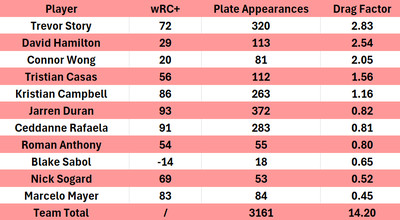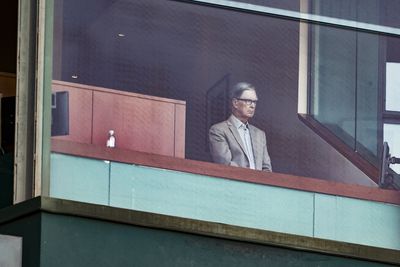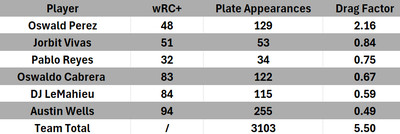
The Red Sox are acting like a small market team with too many unproductive hitters allowed to stay in the lineup.
A decade ago, when I was writing about the Rockies — a small market baseball team that didn’t have enough resources to fill every spot in the lineup with production — I created a nerd metric called “Drag Factor” designed to highlight how much their lousy bats were holding back the club’s overall offensive production. It doesn’t just measure how much guys suck at the plate (wRC+ takes care of that just fine), but it also scrutinizes how many of these infertile plate appearances the team is allowing into the lineup each night.
For my fellow nerds:
The exact equation to calculate Drag Factor is as follows:
Drag Factor = ((100 – wRC+) * Plate Appearances) / Team Total Plate appearances
1) An individual’s Drag Factor can be calculated with the equation above.
2) A team’s Drag Factor can be calculated by adding the Drag Factors of everyone together. The higher the Drag Factor goes, the more it cripples the offense.
In a nutshell, we are looking for everyday players who have a very low wRC+ and a very high number of plate appearances. The more extreme the combination of those two factors, the higher a player’s Drag Factor score is going to rise, which is completely unacceptable if a club has the resources to address and remove it.
When a roster of these scores is added up, it gives you a number that does a surprisingly comprehensive job of quantifying how much “suck” is in a team’s offense, and where it’s specifically located. (For reference, the average team Drag Factor across MLB tends to end up between 11 and 12 most years.)
With that in mind, let’s take a look at where the 2025 Red Sox rank in terms of Drag Factor scores at the halfway point of the season:

If you want a quick glimpse into how ugly these numbers are, consider the 2025 Red Sox team total Drag Factor score of 14.20 is higher than the team total Drag Factor of 13.99 for the 2015 Rockies in the link above. And that was a team that absolutely sucked, lost 94 games, traded away their superstar (welp!), and didn’t have the resources to contend.
When I created this metric, it was with the thought of “how does a small market team best manage its resources to limit the amount of “drag” in the lineup?” For big market teams like the Red Sox, this should be orders of magnitude easier because you can spend your way into populating the lineup with average / 100 wRC+ guys whenever there’s a crippling anchor on the list. Simply removing that suck from the lineup goes a long way to winning baseball games, particularly when opponents lose the ability to target guys with high Drag Factor scores in high leverage situations by pitching around more productive bats.
The fact the Red Sox haven’t addressed this with their resources is grotesque and unacceptable! And actually, they just made it worse by trading Rafael Devers since they took a lineup spot that had a Drag Factor of ZERO for the first 75 games of the season, and so far have replaced it with this:
You think the Boston Red Sox are missing Rafael Devers’ bat?
The Red Sox DH production since the Devers trade:
Batting average: .182.
On-base percentage: .270
Slugging percentage: .273
OPS: .543
HRs: 1 (lone extra-base hit)
RBI: 3
Runs: 3
Walks: 3
Strikeouts: 12
Record: 3-6— Bob Nightengale (@BNightengale) June 25, 2025
They better reinvest that money elsewhere on the roster!!!

Photo By Winslow Townson/Getty Images
It’s no secret the Red Sox have been an endlessly .500 baseball team, but when mired in this mediocrity, it’s easy to overlook how effective removing drag with seemingly more mediocrity can be in baseball. It’s not sexy, but it works!
For more on that, all we have to do is look at the Yankees’ Drag Factor board:
(As a side note, I find it wild DJ LeMahieu appears both here on this list, and in the list from the link above ten years ago. That’s some incredible longevity given his profile.)

Why are the Yankees in first place in the AL East despite Gerrit Cole going for Tommy John surgery and their second best hitter being Trent Grissom with an .831 OPS? Well, at least part of the answer lies in the fact that they don’t tolerate ghastly plate appearances in their lineup for very long. If your wRC+ falls too far below 100, you’re immediately targeted for replacement. In other words, they act like a big market team.
The Red Sox have the financial ability to do this as well, so let’s quickly run through everybody on the Sox Drag Factor list from lowest to highest and examine what they should be addressing and what they should be tolerating:
Marcelo Mayer (0.45): Not worried about this one! Just a young rookie getting his feet wet and playing multiple positions defensively. Completely tolerable!
Nick Sogard (0.52): The number is small for now because he doesn’t have many at bats yet, but this is exactly the type of guy that should get displaced simply by spending some money to put better talent on the roster.
Blake Sabol (0.65): Already sent to Worcester (where he also absolutely stinks!), but his presence here does offer a quick glimpse into how screwed the Sox are if Carlos Narvaez falls off or gets hurt.
Roman Anthony (0.80): Not only am I not worried about this one (his Drag Factor score will be going to zero soon), but I’d argue he’s had such rotten batted ball luck out of the gate that the first 15 games of his career might end up being the unluckiest 15 game stretch he ever has in a big league uniform. Dan Secatore went into more detail on this on Tuesday.
Ceddanne Rafaela (0.81): Tolerate it! Not only has he shown some improvement at the plate this season, but when you cover the ground he does in center field, you accept a little drag in the lineup.
Jarren Duran (0.82): Now we’re starting to get into some of the more problematic entries on the list. If Jarren Duran isn’t going to be an engine in the lineup, his everyday presence here has to come under fire.
Kristian Campbell (1.16): For now, the Red Sox are addressing this by trying to get him reset in Worcester, but his high mark here originally stems from the team rushing him to the big leagues because he was willing to play ball on the contract situation. Hopefully, Campbell is able to right the ship and doesn’t appear on this list very often in the future, and as far as this season goes, hopefully he’s able to come back, be productive, and shrink the number himself.
Triston Casas (1.56): He’s already out for the season, so this Drag Factor figure will naturally get smaller and smaller as his plate appearance total starts to represent a smaller and smaller percentage of the team’s total plate appearances. Casas should end the season with a Drag Factor score of around 0.78.
Connor Wong (2.05): Now we get into some real radioactive stuff! Wong has been stunningly horrific at the plate this season, and he’s the perfect example of a guy that should be targeted for Worcester instead of being allowed to fester and maybe figure it out at the big league level. He’s also the perfect example of how the front office is too passive when it comes to removing drag from the lineup as they had a chance to replace him with Yasmani Grandal a few weeks ago.
David Hamilton (2.54): What exactly does he do that’s productive? Serious baseball teams do not allow somebody with his profile to accumulate this many plate appearances. Remove him from the big league roster immediately!
Trevor Story (2.83): Story is the most uncomfortable guy on this list to address given the contract, his past success, his role in the clubhouse, and his solid defense. The most prudent course of action is likely to slowly decrease the number of plate appearances he gets when Alex Bregman comes back by sprinkling in Mayer at short, but if his production turns totally sour, then you have to have some truly uncomfortable conversations.